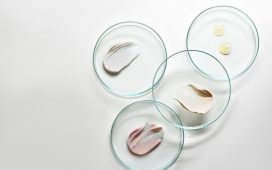Cheesy buckwheat crepes with egg and ham
Buckwheat flour is one of my favourite flours to bake with, it goes with both savoury and sweet so the toppings or fillings for these crepes are endless. This will probably make a few more crepes than you need but the mixture keeps well in the fridge for up to a week.
Serves 4 vegetable oil for frying
gruyere 200g, grated
eggs 4
coppa, speck or prosciutto 100-150g
For the crepe batter
buckwheat flour 100g
millet flour 100g
eggs 3
olive oil 1 tbsp
salt ½ tsp
milk 450ml
malt extract 1 tbsp
Whisk all of the ingredients for the crepe batter together, strain the batter into another bowl and leave to rest for 20 minutes.
Preheat the oven to 100C/gas mark ¼ and line a baking tray with parchment paper; you will need to keep the crepes warm in between frying the rest.
Rub some oil into a 20-23cm cast iron frying pan with kitchen paper, then heat until the pan is very hot but not smoking.
Keep stirring the batter to prevent it from separating before ladling it into the hot pan. Ladle in about 50ml for each crepe, then sprinkle 50g of the grated gruyere over. When the underside of the crepe is becoming golden and the edges easily come away from the frying pan, fold the crepe in half from edge to edge.
Place the folded crepe onto the lined baking tray and keep warm in the oven. Repeat with the remaining batter and cheese.
Once all of the crepes are warming in the oven, fry the four eggs in a separate pan. Serve the crepes with the fried eggs and cured ham on top.
Radicchio frittata with warm bacon salad

I love salad for every meal of the day but especially brunch. Radicchio can often be on the bitter side, but grilling or frying it really tempers that bitterness. The crisp texture is amazing with the silky egg frittata.
Serves 4
For the frittata
radicchio 1 head, cut into 8 wedges
plain flour 40g
olive oil 125ml, plus 3 tbsp
sea salt and black pepper
eggs 8 large
parmesan 20g
For the salad
oak leaf lettuce 1 head, leaves separated – little gem can be used instead, but use 2 heads
smoked streaky bacon 4 rashers
sourdough bread 2 small pieces
garlic ½ peeled clove
flat-leaf parsley ½ bunch, leaves picked, to finish
sea salt and black pepper to taste
For the dressing
sherry vinegar 3 tbsp
extra virgin olive oil 3 tbsp
banana shallot ½, very finely sliced and broken apart
garlic ½ clove, peeled, finely minced
First, prepare the dressing for the salad by whisking all of the ingredients together, then set aside. Thoroughly wash and dry the lettuce leaves and place in the fridge.
To make the frittata, remove the outer leaves of the radicchio, trim the bottom and cut the head into eight equal wedges. Rinse the wedges and shake off excess water, pat dry with kitchen paper then gently press each wedge into the flour to cover all over. Shake off any excess.
Heat the 125ml of olive oil in a large frying pan and fry the wedges on a high heat for about 3-4 minutes on each side. Remove them from the frying pan, leave to drain on a paper towel and sprinkle with sea salt.
In another pan, fry the bacon for the salad over a medium to high heat until crisp; remove from the pan and leave to drain on a paper towel while you make the frittata. Reserve the excess bacon fat in the pan for later.
Beat the eggs in a bowl with a pinch of salt and crack of pepper. In a 25cm ovenproof frying pan, heat the remaining three tablespoons of olive oil until very hot but not smoking. Arrange the fried radicchio in the pan in a single layer and then pour the egg mixture over.
Using an oven mitt, hold the frying pan handle with one hand and support it with the other. Swirl the pan in a circular motion to evenly distribute the egg, then cook the frittata for around 7 minutes. Resist the temptation to stir as this will cause it to stick.
While the frittata is cooking, warm the pre-made dressing in the pan you used to fry the bacon, being careful not to brown the shallots and garlic. Rub the two slices of bread with the halved garlic clove and tear the bread into the pan. Add the contents of the pan to a large bowl along with the salad leaves and toss with the whole parsley leaves. Drizzle the salad with a little more oil, as the bread will absorb a lot of the oil from the pan. Season with salt and pepper.
Take the frittata pan off the heat and place under a preheated grill for 2 minutes and then sprinkle with the parmesan. Serve immediately with the salad.
Anaïs Nin’s cheese soufflé

I’ve been thinking about this soufflé since I first watched Henry & June, the 1990 film by Philip Kaufman, where the then unpublished Henry Miller is beginning his affair with Anaïs Nin, who serves the soufflé to her guests and Henry takes the entire top for himself.
Serves 4
unsalted butter 80g, plus 25g very soft butter for greasing the dish
parmesan 20g, grated, plus more for grating over
eggs 4 large
flour 3 tbsp
milk 240ml
gruyere 125g, grated
cream of tartar 1 tsp
salt and pepper to taste
salad or wilted greens to serve
Preheat the oven to 220C/gas mark 8.
Rub a 20-23cm soufflé dish or any other ovenproof baking dish with the 25g of very soft butter, sprinkle with the 20g of grated parmesan and set aside.
Separate your eggs, place the whites into a clean stainless steel bowl and reserve the yolks for later.
Melt the 80g of butter in a medium-sized saucepan. Once it starts to sizzle, add the 3 tablespoons of plain flour and whisk continuously until it starts to smell biscuity. Next, pour the milk in a steady stream into the pan, whisking continuously until it thickens, taking care not to scorch the bottom of the pan.
Take the pan off the heat and stir a few times to release some of the steam and then whisk in the reserved egg yolks one by one. Next, stir in the grated gruyere and add salt and pepper to taste. Set aside to cool.
Add the cream of tartar to the bowl of egg whites and whisk until soft peaks form. Fold one quarter of the egg whites into the cooled cheese sauce and then fold the remaining egg whites in, retaining as much volume as possible.
Scrape the mixture into your prepared dish and grate a good amount of parmesan onto the top before putting it into the oven. Bake for 25 minutes or until evenly puffed on the top. Serve immediately with a salad or wilted greens.
Multigrain porridge with kale, hazelnuts and smoked fish

Savoury porridge is something I started eating a few years ago, after I first had it at a restaurant in northern California. I’m a big fan of starting the day with savoury instead of sweet, probably because I am constantly around sweet things the rest of the time. This porridge is so nourishing and great for wintertime. You can also add an egg for extra protein.
Serves 4
greens 300g, preferably spring greens, cavolo nero or collard greens
hazelnuts 100g, toasted and roughly chopped
lemon juice of ½
good olive oil 1 tbsp
multigrain porridge oats 200g
water 1 litre
Greek yogurt 250g
olive oil
Aleppo chilli flakes a sprinkle, or other red chilli
hot smoked trout 50g, or salmon or mackerel
Remove the stalks from the greens and rinse, pat dry and slice into ribbons. Char the leaves in a dry skillet or under the grill, and turn until charred.
Toss the chopped, toasted hazelnuts, the olive oil and lemon juice in a bowl with the charred leaves and set aside. Prepare the multigrain porridge by putting the oats in a medium saucepan with your chosen milk or water over a medium heat and stirring continuously until you have a creamy consistency.
Portion up the cooked porridge into bowls with a scoop of Greek yogurt and the charred greens, add a final drizzle of some good olive oil and a sprinkle of Aleppo chilli. Serve with the hot smoked fish.
The Observer aims to publish recipes for fish rated as sustainable by the Marine Conservation Society’s Good Fish Guide
Apple and custard brioche buns

These brioche buns take a bit of time but they are so worth it. You could alter the topping to a savoury one, too, but I love traditional apple and custard. Also, you can do so much with the buns, such as making a cinnamon bun or babka pudding.
The dough and custard for these can be made ahead of time and you can freeze a quantity of the dough if you wanted to make fewer than 12 buns.
Makes 12 buns
For the pre-ferment
skimmed milk 150ml
active dry yeast 7g (1 sachet)
strong white bread flour 150g
For the brioche dough
eggs 3 large
whole milk 150ml
strong white bread flour 400g
caster sugar 2 tbsp
sea salt 1½ tsp
active dry yeast 14g (2 sachets)
unsalted butter 125g, cold, cubed
For the custard
milk 250ml
salt ⅛ tsp
caster sugar 4 tbsp
cornflour 2 tbsp
eggs 2 large
unsalted butter 30g, cubed
For the apple filling
cooking apples 2-3 (about 500g)
unsalted butter 25g
salt a pinch
golden caster sugar 100g, plus extra for sprinkling
water 1 tbsp
For the egg wash
eggs 2 yolks
milk 2 tbsp
Line one or two trays with baking parchment, depending on whether you are making a half or full batch.
Combine all the ingredients for the pre-ferment in a standing electric mixer and beat until smooth with the dough hook attachment. If you don’t have a standing mixer, you can hand mix with a wooden spoon. Once you have a smooth mixture, refrigerate for 30 minutes to one and a half hours.
While the pre-ferment is in the fridge, weigh out all the ingredients for the brioche dough except for the butter.
Whisk together the eggs and milk in one bowl and in a separate bowl, whisk together the bread flour, sugar, salt and yeast.
Remove the pre-ferment from the fridge and gradually add the wet and dry dough ingredients to the pre-ferment mixture until combined and smooth.
Let the mixture rest for 20 minutes and then add the cold cubed butter and mix for another 10 minutes or until smooth.
Put the dough into a small airtight container that will fit in your freezer for 2 hours or refrigerate overnight.
Make the custard while the dough is chilling. Prepare a bowl in an ice bath to have on hand for when you need to stop the cooking process of the custard. Heat the milk, salt and sugar over a medium heat – be careful not to burn it. In a separate bowl, whisk together the egg and cornflour and add to the heated (not boiling) milk mixture. Whisk until thick but not curdled.
Sieve the heated mixture into the bowl that is sitting in the ice bath, and once you have done this add the cubed butter and mix until completely melted. If the mixture becomes lumpy, you can use a food processor to blend it smooth again.
Preheat the oven to 180C/gas mark 4.
Peel, core and roughly chop the apples. In a saucepan, melt the butter, the salt and the 100g of sugar, and then add the chopped apples and the water. Stir the mixture regularly over medium heat until the apples are soft.
Divide the dough into 12 even pieces and shape each into a small ball. You can evenly distribute 6 balls on to your lined baking tray.
Cover with a clean cloth and leave to rest in a warm place for an hour and a half. Make the egg wash by whisking together the egg yolks and milk, then brush it on the rested buns. Use the back of a spoon to create a dip in the back of each bun. Add a heaped tablespoon of custard and a heaped tablespoon of the apple filling to each bun and sprinkle with the extra golden caster sugar.
Bake in the oven for 20-25 minutes or until golden. Serve warm or at room temperature, but they are best eaten on the day of making.
Claire Ptak is chef-owner of Violet Bakery, London E8














